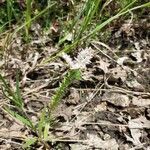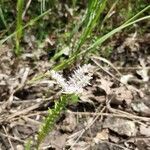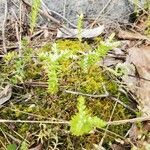Herbs, annual or perennial (by formation of side shoots), rarely biennial, multi-stemmed from base, glabrous. Stems ascending, simple or branched, sometimes bearing rosettes. Leaves alternate, spreading, sessile; blade pale yellow-green, not glaucous, linear to oblanceolate or spatulate, subterete, 5-32 × 1.5-5 mm, base sagittately short-spurred, not scarious, apex obtuse to rounded, (surfaces papillose in rosette). Flowering shoots erect, simple, 6-23 cm; leaf blades linear, base with 2 sagittate spurs (unique in this species); offsets not formed. Inflorescences cymes, 10-40-flowered, 3-branched; branches secund or recurved, not forked; bracts absent or similar to leaves, smaller. Pedicels to 1 mm. Flowers 4(-7)-merous; sepals erect, distinct, light green, linear-lanceolate, unequal, 1.3-5.8 × 0.5-1.5 mm, apex acute or obtuse; petals erect or subdivergent, distinct, white to purple, narrowly linear-lanceolate or elliptic-lanceolate, carinate and slightly channeled basally, 4-10 mm, apex acute or obtuse; filaments white or pinkish; anthers red or purple; nectar scales white, pinkish white, or yellow, square. Carpels spreading in fruit, distinct, light brown. 2n = 22, ca. 42.
More
Mostly biennial from a cluster of fibrous roots, less often annual or perennial; stems simple or often branched at the base, 1–3 dm; lvs numerous, alternate, entire, linear or somewhat clavate, ± terete, 1–3 cm, the basal spur (at least on the flowering stems) commonly sagittate; infl of 3–7 widely divergent or recurved, secund, sympodial cymes to 1 dm; fls mostly 4(–7)-merous; pet pinkish-white to pale pink or purple, ± spreading, 4–8 mm; filaments only very shortly adnate to the pet; frs divaricate; 2n=22, 44, 66. Moist rocks and cliffs, Ky. and Tenn. to Mo., Okla., and Tex. May, June.
Areas of flat rocks, especially openings in cedar glades, ledges of cliffs, and bluffs, in shallow soil or in living mats of moss on rocks, often on limestone, sandstone, and chert; at elevations from 90-500 metres.



